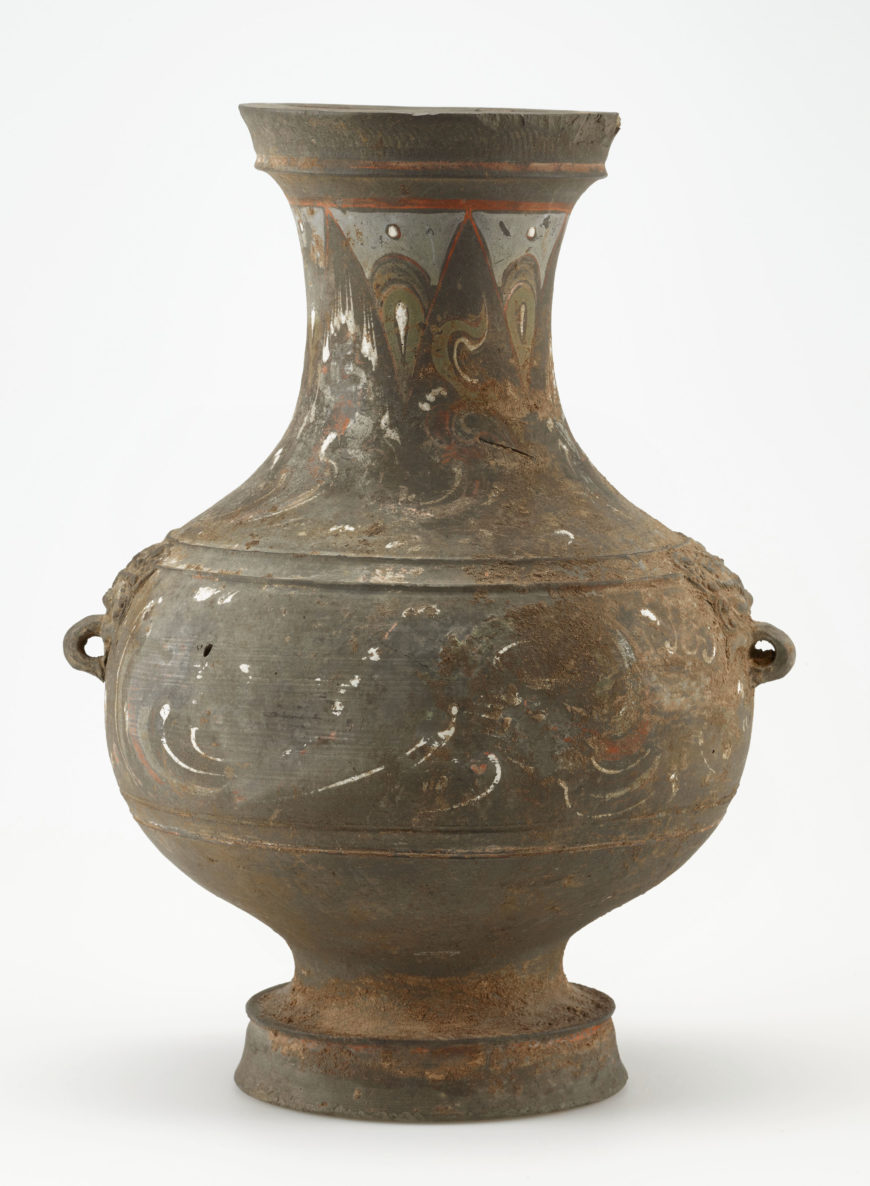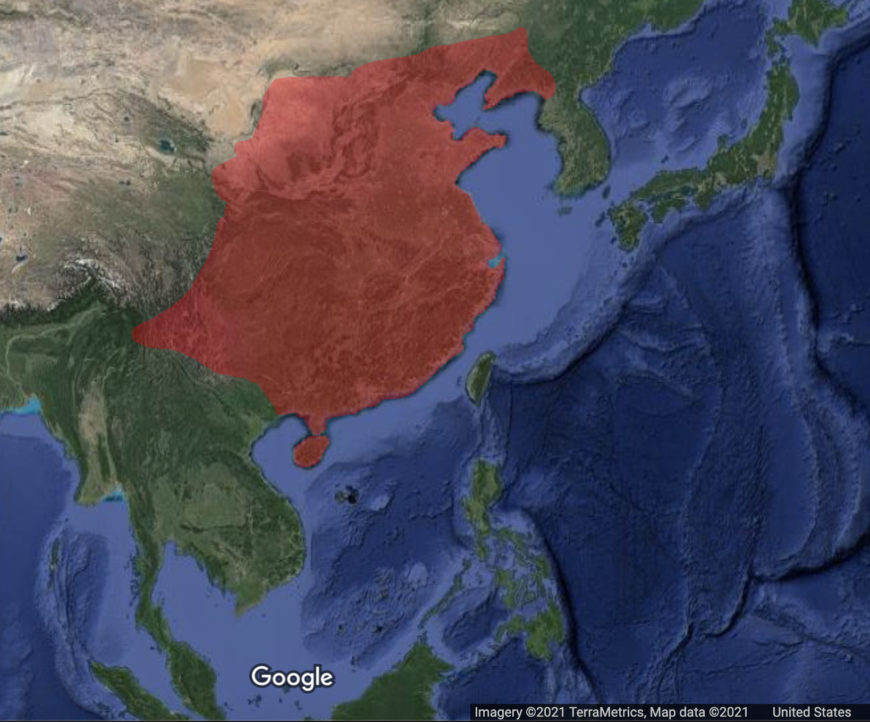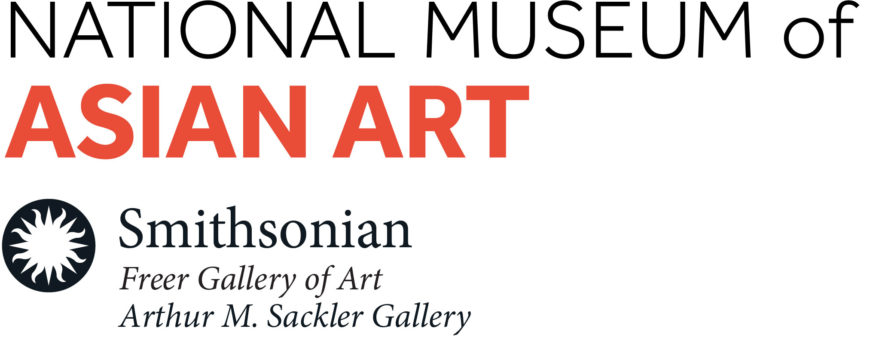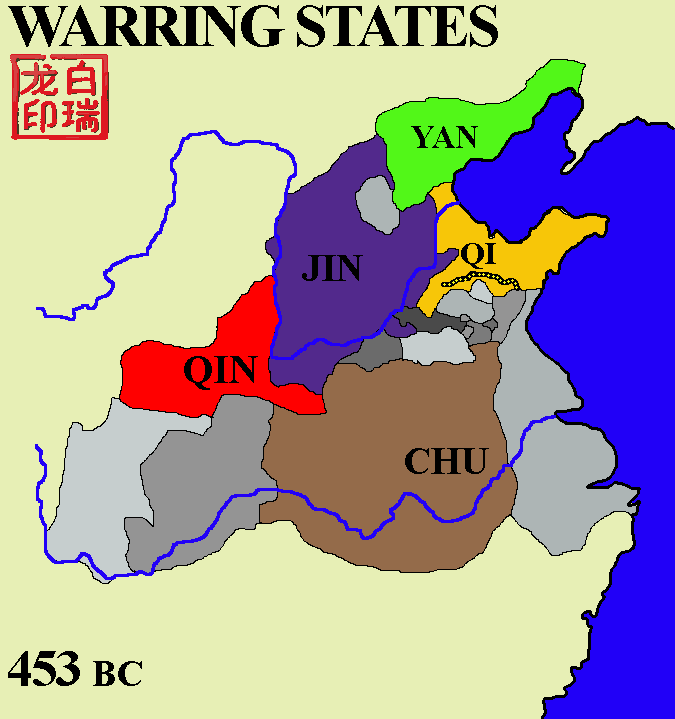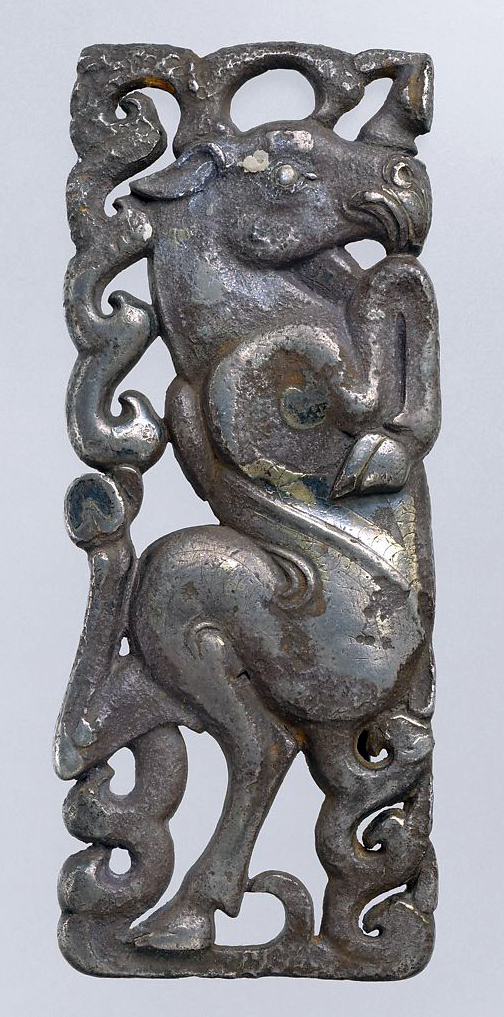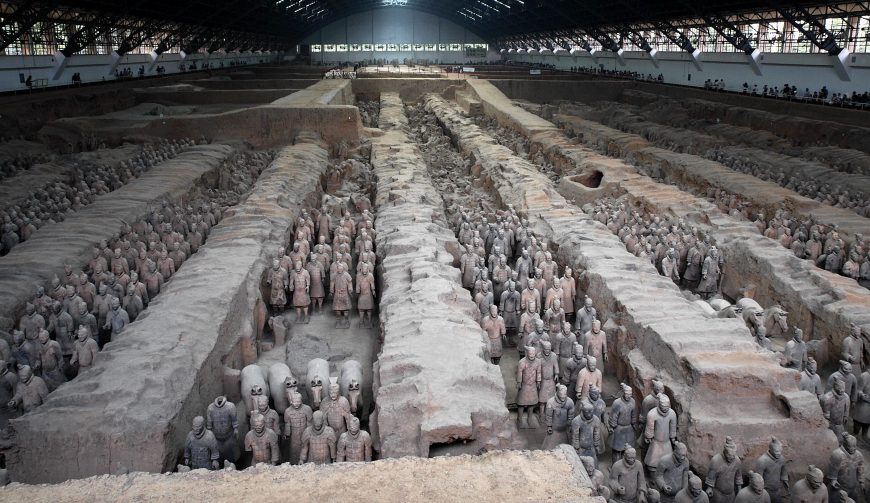
Pit 1, Army of the First Emperor, Qin dynasty, Lintong, China, c. 210 B.C.E., painted terracotta (photo: mararie, CC BY-SA 2.0)
The Tomb of the First Emperor of China was accidentally discovered in 1974 when farmers digging for a well found several ceramic figures of warriors. As the discovery quickly garnered national attention, archaeological investigation revealed three large underground chambers (referred to as “pits”) containing shattered fragments of terracotta warriors. These life-sized, life-like ceramic figures depict warriors, with every detail of their dress skillfully rendered, and still bearing traces of their original paint at the time of their discovery. The terracotta warriors looked unlike any tomb figures that had been known before. What is more, pits 1, 2, and 3 were only a small part of what turned out to be the massive tomb complex of the First Emperor.
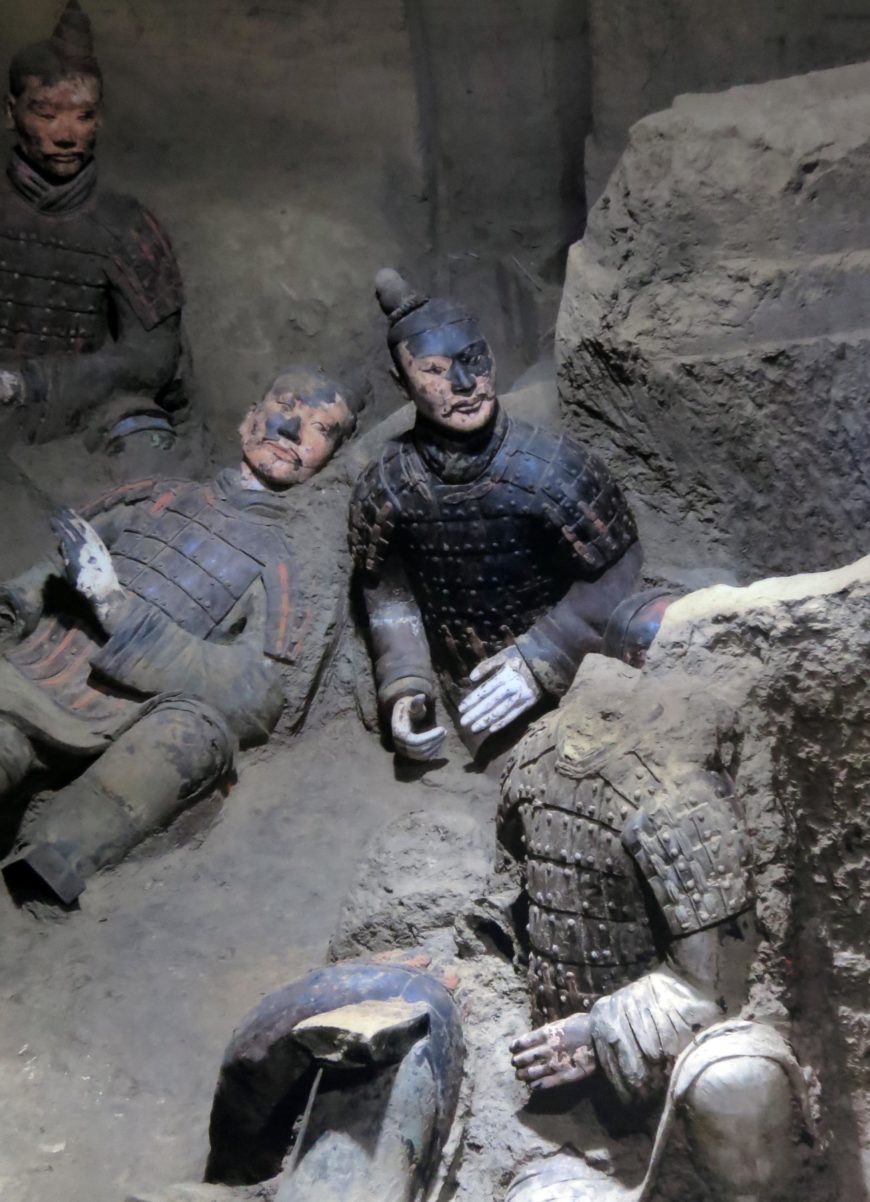
View of the soldiers at their discovery (The Museum of Qin Terra-cotta Warriors and Horses, Xi’an; photo: edward stojakovic, CC BY 2.0)
The First Emperor (born Ying Zheng), initially ruled as the king of the Qin state. Through forceful military campaigns, he conquered the states occupying much of the current territory of China, bringing an end to the Warring States Period. He reformed the culturally and politically distinct states into a single, centralized political entity.
In 221 B.C.E., he officially declared himself Qin Shi Huangdi, a title he coined himself commonly rendered as the “First Emperor” that literally translates to “First August Emperor of Qin.” This was no empty gesture—the First Emperor’s reforms and unification would forever change the meaning of rulership in East Asia.
Among his monumental building projects was a monumental tomb of unprecedented splendor, whose scale and luxury became, with the passage of time, the matter of legend. Nevertheless, none of the fantastic tales found in the written record prepared archaeologists for what they would find in the Mausoleum of the First Emperor.
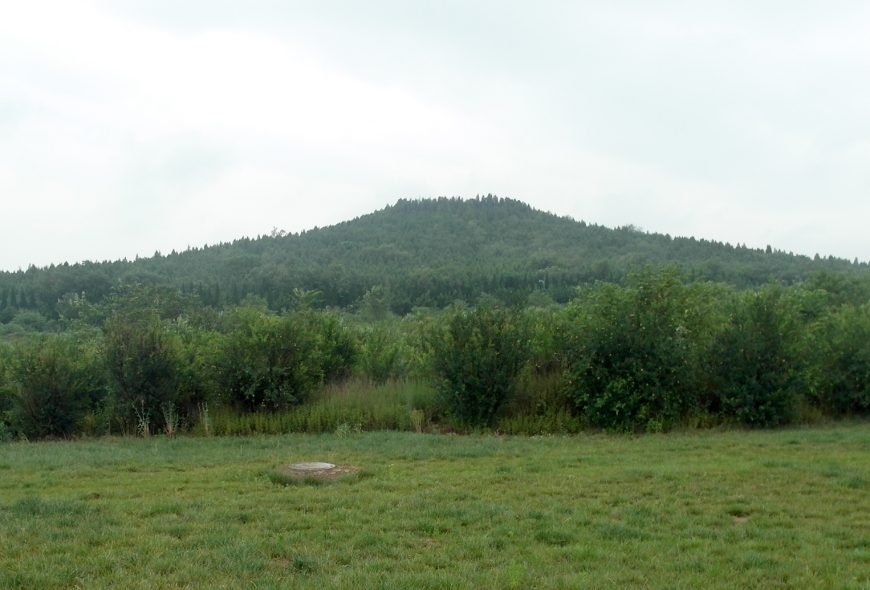
Mausoleum of Emperor Qin Shi Huangdi in 2010 (photo: 申威隆, CC BY-SA 3.0)
The tomb complex of the First Emperor
The mausoleum is a vast tomb complex which covers an area of 6.3 square kilometers or 3.9 square miles, and which is centered around a tumulus (at no. 1 in the diagram below). Dominating the landscape, the tumulus was long known to mark the burial place of the First Emperor, but the scale of the underground complex was unknown before the discovery of the three pits (called the Army Pits).
The First Emperor’s tomb complex is often called a mausoleum (no. 2 in the diagram below), but this does nothing to convey the scale and complexity of the network of pits, accompanying tombs, and above-ground structures that surround the burial chamber under the tumulus. For instance, the Army Pits are .75 miles away from the mausoleum! After more than 30 years of excavation, starting with the original discovery in 1974, only a fraction of the full extent of the complex has been excavated, with new discoveries being made every year.
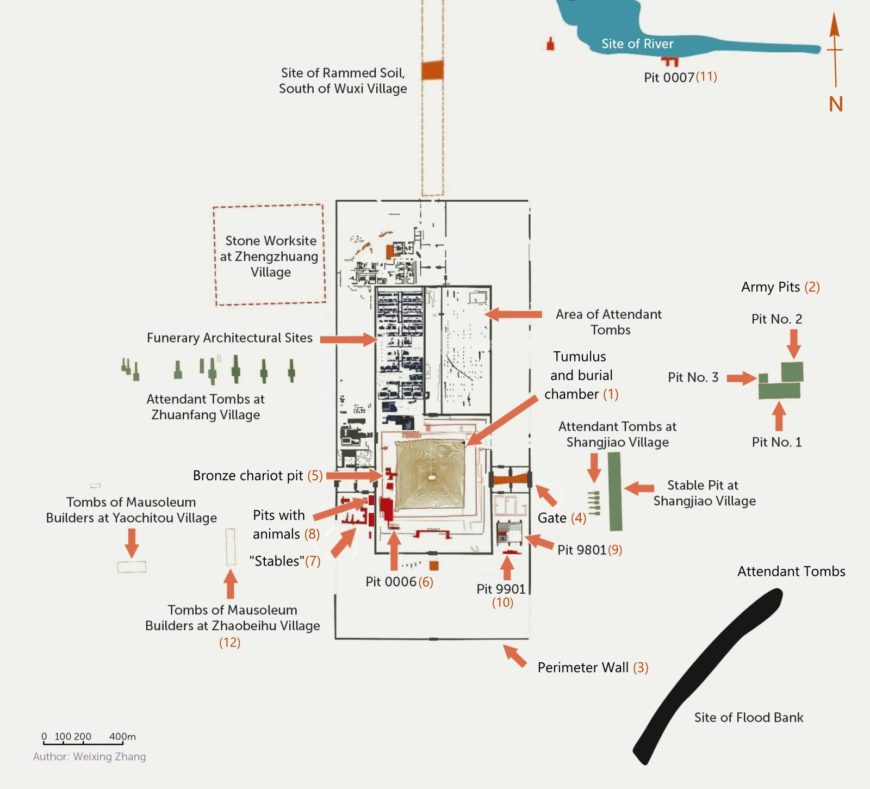
Diagram of the tomb complex, Mausoleum of Emperor Qin Shi Huangdi (diagram Weixing Zhang; modified by Alexandra Nach). The pyramid-shaped tumulus and the Army Pits, currently the site of the Museum of the Tomb of the First Emperor, are 1.22 km/0.75 miles away from each other. Each of the pits and objects discussed in this essay are labeled with orange numbers.
Two above-ground walls (no. 3 on the diagram) formed the perimeter of the tomb complex (which included the tumulus). Originally the walls were 10m thick, and were pierced by monumental gateways (no. 4 on the diagram) that no longer exist though the openings remain visible. The burial mound occupies the southern side of the walled enclosure, while the northern side is split between a walled-off section containing 34 unopened companion tombs and a complex of above-ground ritual buildings (no longer standing) where sacrificial rites were performed for the deceased emperor as part of rituals of ancestor worship. A vast underground complex—encompassing a network of pits and smaller tombs of humans and animals, as well as underground walls and drains ensuring the stability of the structure—stretches underneath the walled enclosure, as well as beyond it.
Beneath the tumulus lies the burial chamber of the First Emperor. It has not yet been excavated, primarily out of concern for properly preserving its contents during excavation. However, using scientific surveying methods such as magnetic anomaly surveying, archaeologists have been able to identify the location and size of the burial chamber, and discover that subterranean walls of brick and tamped earth surround the tomb chamber to protect it from being flooded by the high water table.
One important written source, the Shiji (Records of the Grand Historian) written by Sima Qian around. the year 94 B.C.E., gives us a description of the burial chamber:
Replicas of palaces, scenic towers, and the hundred officials, as well as rare utensils and wonderful objects, were brought to fill up the tomb. […] Mercury was used to fashion imitations of the hundred rivers, the Yellow River and the Yangtze, and the seas, constructed in such a way that they seemed to flow. Above were representations of all the heavenly bodies, below, the features of the earth.Quoted in Records of the Grand Historian: Qin Dynasty by Burton Watson, p. 63
As tantalizing as this passage is, it should be read with some caution. Sima Qian was writing a history for the dynasty which conquered that of the First Emperor, and more than a century after his death. While Sima Qian remains a major source of information on the First Emperor and his tomb, the author consistently sought to depict him as a tyrannical, excessive ruler. We may not know for certain whether the tomb vault contains rivers of mercury and a dome depicting the celestial vault—however the passage has provided scholars with important clues on how to understand the different pits and spaces in the tomb complex. Sima Qian describes a tomb complex that aims to replicate the buildings, geographic features, imperial possessions, and the very inhabitants of the Qin Empire.
This is a dramatic development in how Chinese tombs were conceived. Since the early Bronze Age, Chinese ruling elites had taken bronze ritual vessels, ceremonial musical instruments, and chariots with sacrificed horses into their tombs. By the Qin dynasty, all of these items had become established symbols of rulership. In the Warring States period preceding the First Emperor’s unification, rulers had begun to segment their tombs into compartments resembling rooms, indicating a shift towards imagining the tomb as a replica of a dwelling, or even a palatial compound. But nothing comes close to the all-encompassing program of the First Emperor’s tomb. Where earlier rulers had been content to bring their valued weapons, ritual vessels, and horses with them into the afterlife, the First Emperor re-created entire stables and garrisons, and enlivened them with terracotta figures performing the everyday tasks of government.
What follows are descriptions of several of the most important archaeological finds in the tomb complex, each interpreted as a recreation of the world of the First Emperor within the space of his mausoleum.
Getting around
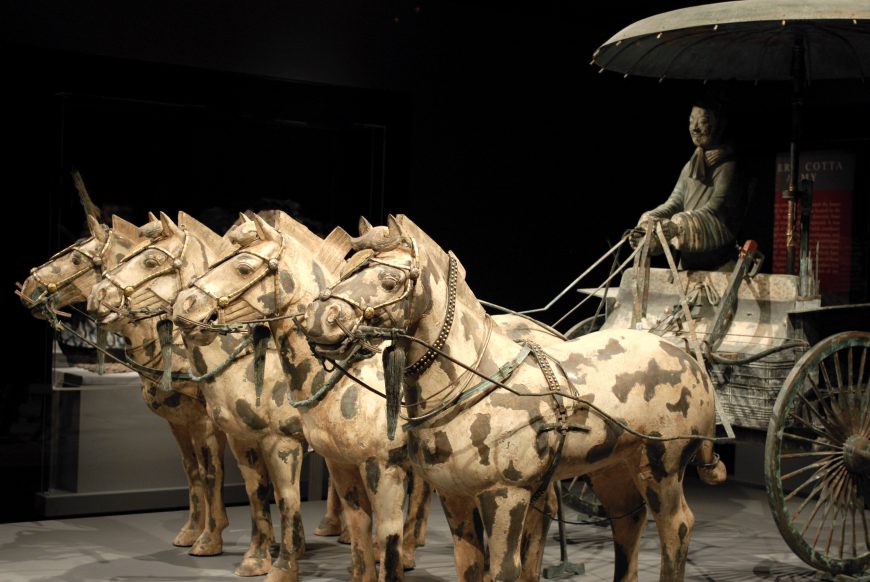
War Chariot (first chariot), Mausoleum of Emperor Qin Shi Huangdi, c. 210 B.C.E. (photo: Tiffany, CC BY-NC 2.0)
One important find within the perimeter of the walls is a 50-meter-long pit containing two bronze chariots (no. 5 on the diagram) one bearing a canopy and one a closed compartment. Both vehicles faithfully replicate every component of a wooden chariot— but in bronze, and at a scale of half the size of their real-life wooden counterparts. The chariot with the canopy is manned by a figure equipped with a crossbow, and is positioned in front of the second vehicle.
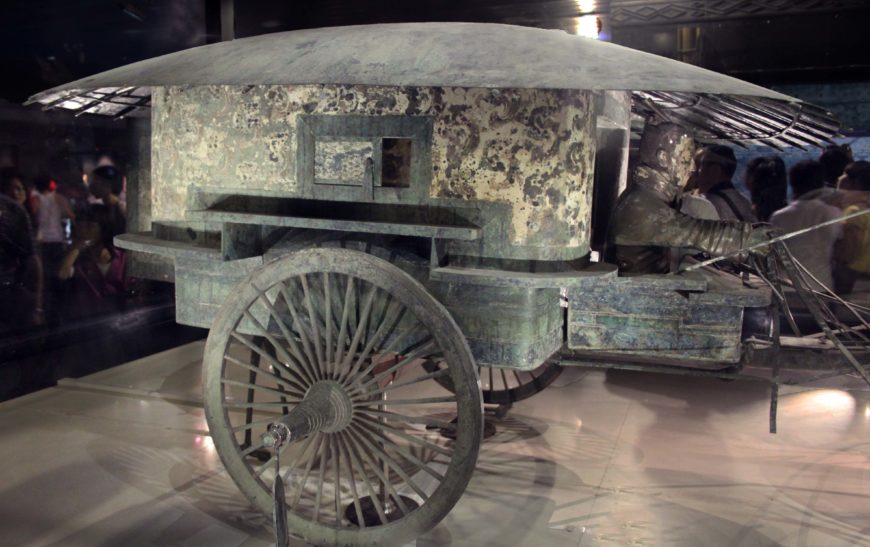
Second Chariot, Mausoleum of Emperor Qin Shi Huangdi, c. 210 B.C.E. (photo: Gary Todd)
The second chariot is driven by a kneeling figure and features a closed compartment with windows and a sloping roof. Elaborate cloud and lozenge patterns painted on the bronze walls of the compartment are still visible. This lavish chariot matches the descriptions of the vehicles employed by the Emperor during his tours of the empire, leading archaeologists to suggest the bronze chariots are models of the First Emperor’s actual vehicles. As tempting as it is to imagine the spirit of the Emperor journeying in these carriages, where he would journey to is hotly debated. Researchers have suggested that the chariots might carry the emperor to a distant afterlife or could help him retrace his imperial tours after his death. Others have suggested they could simply carry his spirit to the recreation of his pleasure gardens at the far side of the tomb complex.
Getting things done in the empire
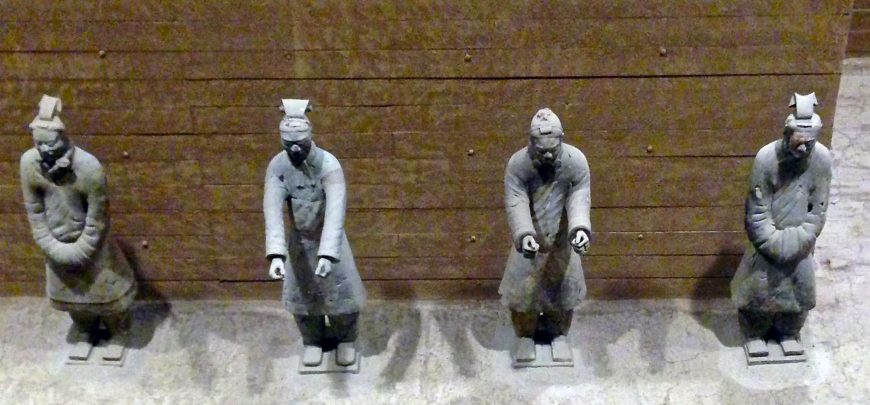
Overhead view of Pit No. K0006 (photo: Bairuilong, CC BY-SA 4.0)
Another pit (no. 0006; no. 6 on the diagram) housed twelve terracotta figures dressed in long coats with broad sleeves and distinctive headgear identifying them as officials—their coats even show tools for correcting writing errors on bamboo. They represent the bureaucracy that ran the Empire.
The Emperor’s menagerie
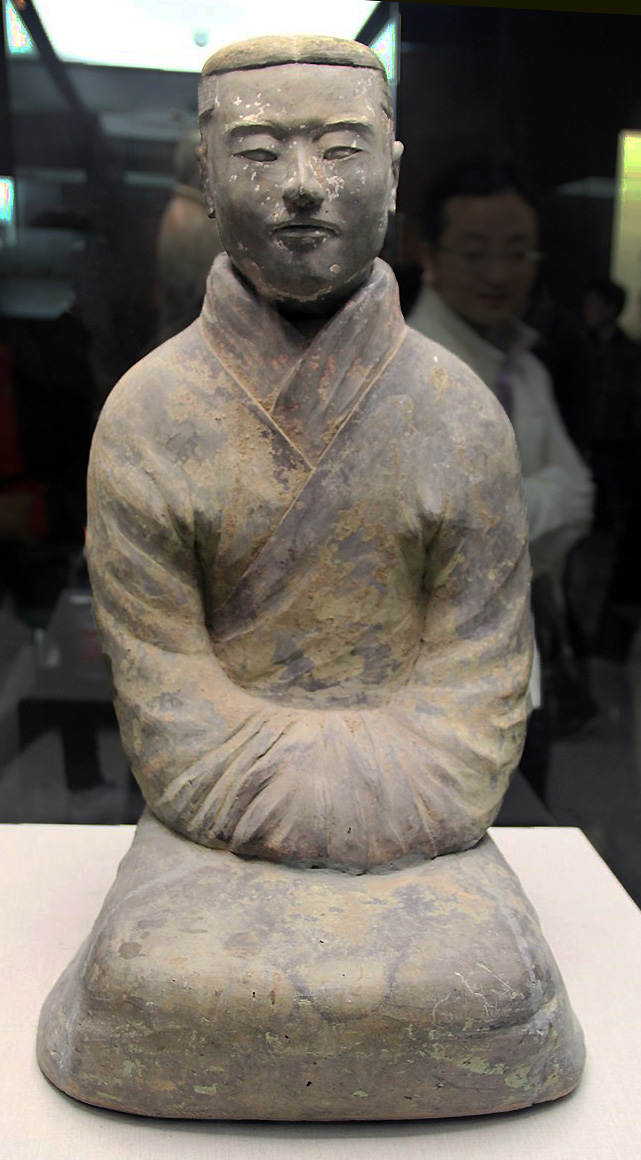
Terracotta attendant found in the animal burial pits (photo: Gary Todd)
One large pit to the west of the inner wall contains hundreds of sacrificed horses (no. 7 on the diagram), assumed to have belonged to the imperial stables. Other smaller pits nearby contain individual animals, including exotic breeds of deer and birds, all in ceramic caskets. These are assumed to be from the Emperor’s zoo. The remains of the animals were guarded by ceramic attendants and grooms (no. 8 on the diagram). While sacrificing horses for the burial of elites was a long established practice in China, the First Emperor’s mausoleum surpasses all earlier tombs through the sheer number of animals sacrificed. The presence of grooms and terracotta attendants turns a burial into a recreation of the space of the stable—archaeologists even found traces of hay on the floor.
Otherworldly armor
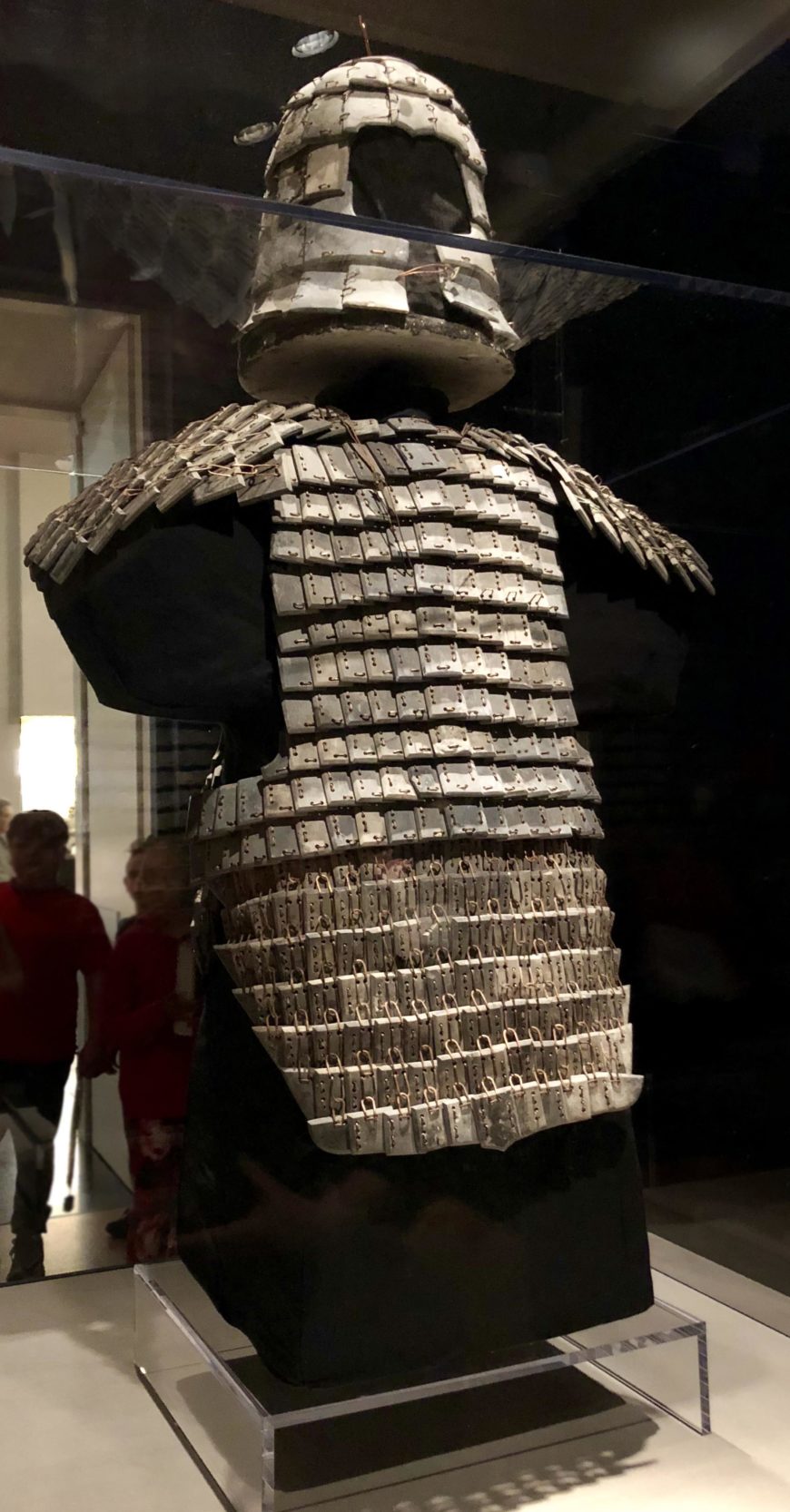
Lamellar armor found in Pit No. K9801 (photo: anokarina, CC BY-SA 2.0)
Meanwhile, pit K9801 on the eastern side (no. 9 on the diagram) contains another mystery—87 sets of armor, each made out of 80 small stone plates connected with bronze wire, as well as helmets made the same way. Each set of this otherworldly armor was too heavy and constrictive to have ever been used in combat. Why was this armor made out of stone, rather than clay or other materials?
Starting from the 4th century B.C.E., Chinese tombs often included copies of everyday objects purposefully made out of the “wrong” material, referred to as mingqi (translated as “spirit articles”). However, stone armor plates are unique to the tomb of the First Emperor, and these are the only articles in the tomb to be made out of stone.
One theory argues that stone was thought at the time to have apotropaic (meaning that it could ward against ghosts and evil spirits) properties. The stone armor, so the argument goes, was provided in case the faithful terracotta warriors would have to face off against a supernatural threat against the First Emperor’s spirit—perhaps even the angry ghosts of his former enemies.
Entertainers
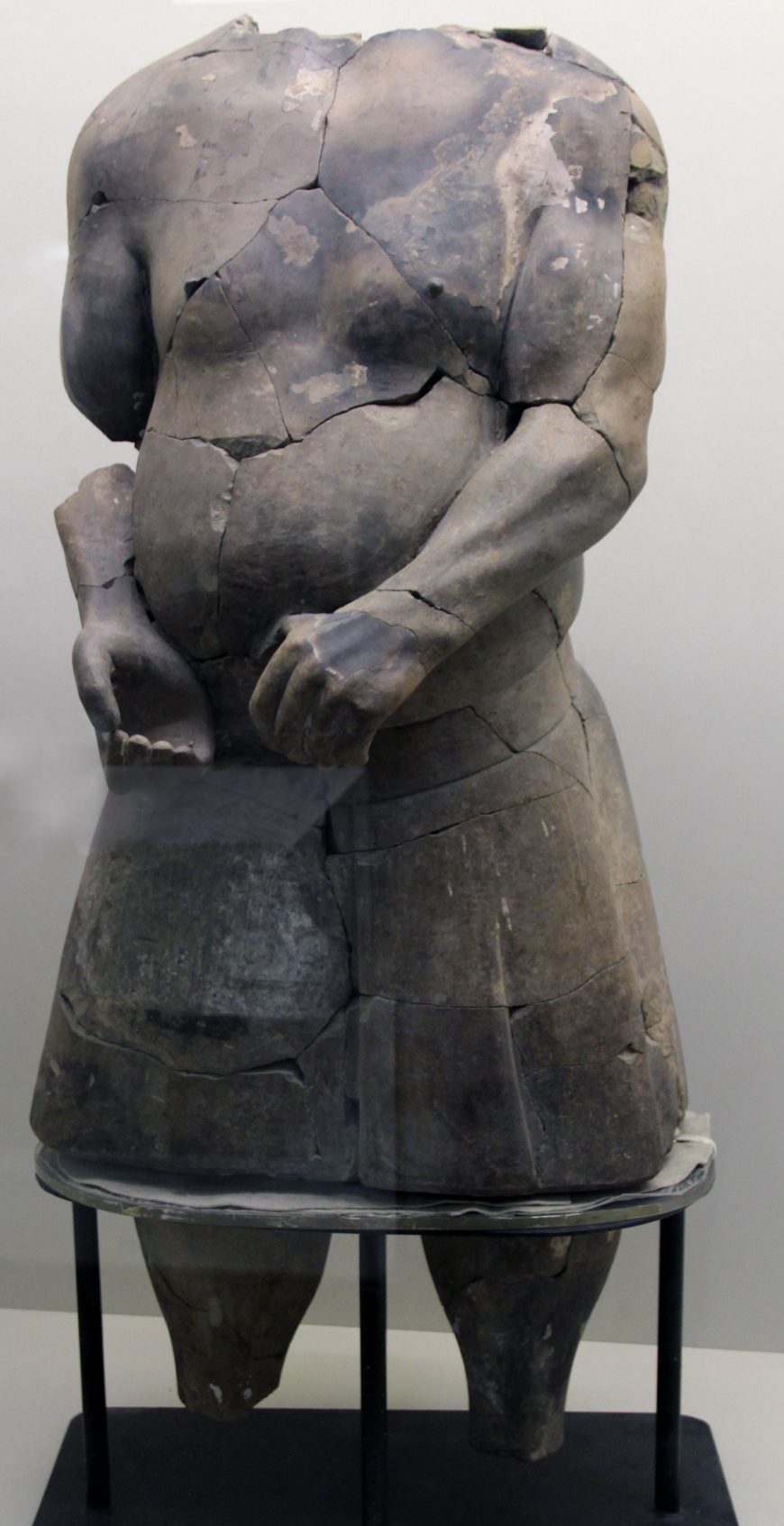
Figure of the “strongman” from Pit K9901 (photo: Gary Todd)
One of the most spectacular finds is a pit K9901 (no. 10 on the diagram) containing half-clothed figures, each unique and with differing physiques. One (known as a “strongman”) flexes his strong arms and muscular shoulders, as if tugging on a weight. These figures are commonly known as the “Acrobats,” thought by some to represent a troupe meant to provide entertainment for the Emperor in his afterlife.
Other explanations, however, have been offered, such as the bare-chested figures representing soldiers in training, or figures engaged in a competition of “cauldron lifting.” The presence of a massive and beautifully cast cauldron in the same pit could be explained by this theory. Scholars have argued that such weight-training competitions involving lifting heavy bronze cauldrons, which often took place at autumn religious festivals, functioned as a display of both physical prowess and military might.
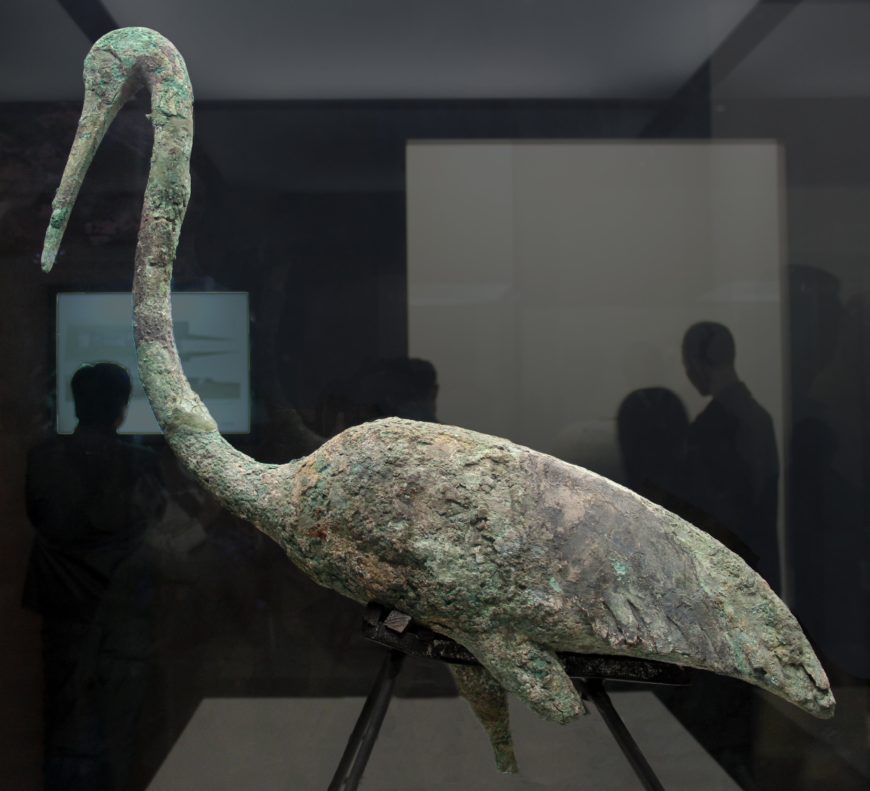
Bronze crane found in Pit K0007 (photo: Gary Todd)
Outside the rectangular walls of the tomb precinct, other finds connected to the tomb have been excavated. A trench covers the length of the F-shaped pit K0007 (no. 11 on the diagram), its floor covered in mud, indicating its function as a water basin. It was surrounded by ledges on which bronze waterfowl were perched. On make-shift windows in the pit there are also kneeling figures who likely once held wooden instruments —entertainers in an underground garden.
Imperial parks, large enough to hold hunting parties, were an important symbol of royal power for Chinese rulers. Scholars have identified a high terrace known as Hongtai, the “Terrace of Wild Swans,” built for the Emperor to shoot wildfowl from the park of one of his palaces as a potential inspiration for Pit K0007.
Companion tombs
Both inside and outside the tomb precinct, a large number of other tombs have been found. The tombs inside the precinct, though not yet opened, could possibly belong to concubines and close relatives of the First Emperor—written records suggest that some offered to join their Emperor in death, while others were forced to.
Meanwhile, several hundred much plainer tombs have been found (located by the current-day Zhaobeihu Village, no. 12 on the diagram, west of the walled burial complex) that contain the remains of the prisoners and laborers forced to work on the tomb. Some of these tombs contain small ceramic fragments that indicate the name, hometown, rank, and sometimes in the case of prisoners, what their punishment was. Incision marks on bones found in these tombs attest to the severe physical punishment suffered by some of the builders. The remains of women and children were also found, possibly victims of the principle of kin liability practiced by the Qin, which stipulated that the entire family be punished for the crime of one member. The remains of the laborers remind us of the human cost of the tomb’s magnificence.
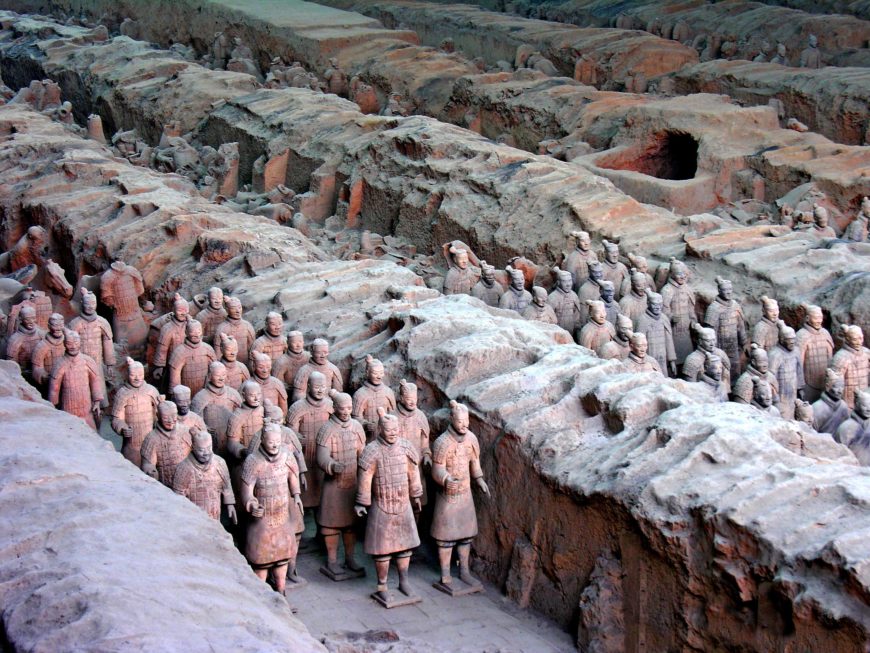
Pit 1, 230m/754 feet long, 62m/203 feet wide and dug 5m/16.4 feet deep into the ground, Mausoleum of Emperor Qin Shi Huangdi, c. 210 B.C.E. (photo: Dennis Jarvis, CC BY-SA 2.0)
The Army Pits and the Terracotta Warriors
The three pits known as the Army Pits (no. 2 on the diagram, and includes Pit nos. 1, 2, and 3) are by far the most famous. The thousands of warriors found inside were accompanied by wooden chariots and terracotta horses. Each of the ceramic figures bears individually modeled armor, hairstyles, and headdresses that make every figure stand out as unique, and allow distinction between the ranks of the soldiers and their different roles in an army—from archers to infantrymen to charioteers. Showing such a vast army, exemplifying the military dominance of a state that depended on being able to assemble the largest numbers of warriors.
The image of an Emperor
As we have seen, the tomb of the First Emperor is unique in Chinese history in its scale and its use of detailed, life-scale figures. However, we can only speculate as to how the tomb actually “worked.” Was it meant to serve as a literal resting place for the First Emperor’s soul, where the skillfully rendered servants and soldiers would become enlivened to serve the deceased ruler in the tomb? Or would the magnificent underground palace only serve as a temporary abode that the spirit of the Emperor would regularly return to in order to receive the sacrifices performed in the temples surrounding the burial mound? Or did the elaborate pits and spaces of the tomb complex provide a “model” for the afterlife that the spirit of the First Emperor would be traveling to?
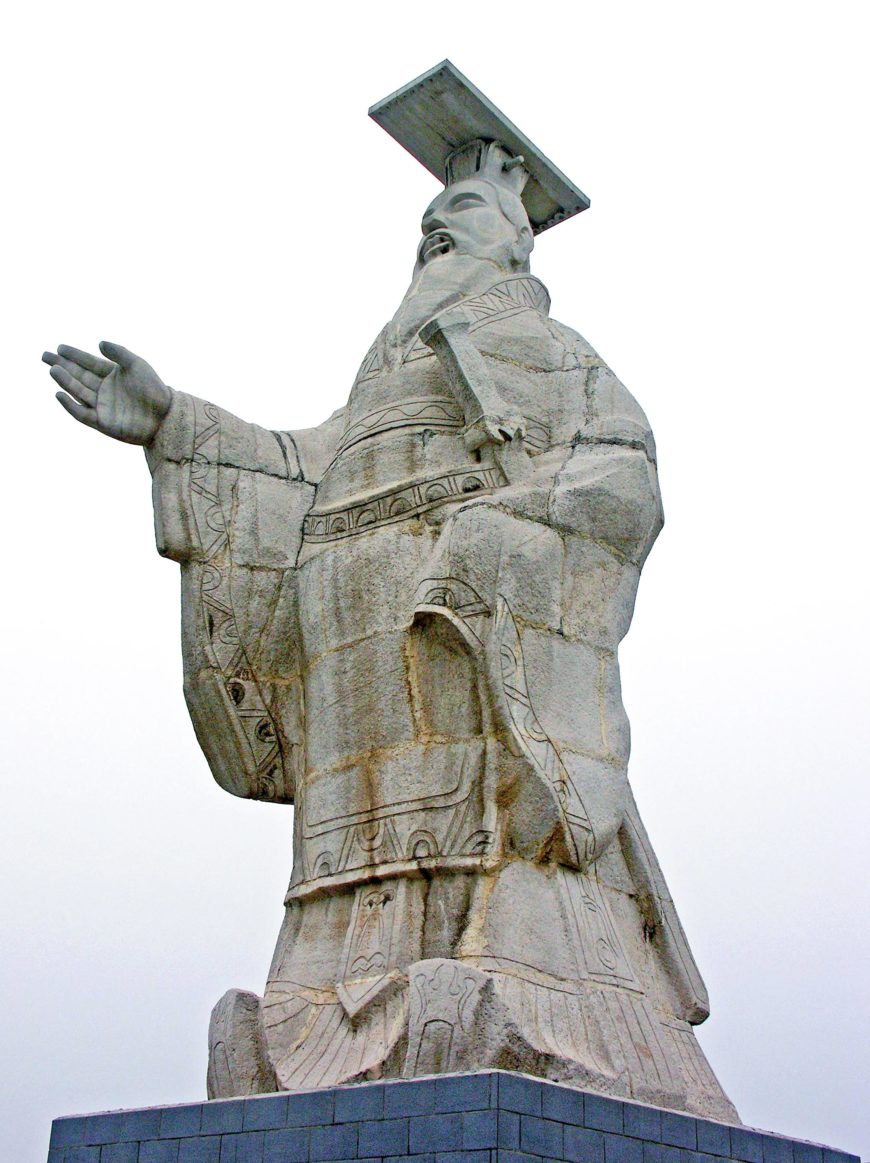
Modern statue of Qin Shi Huang in front of the Museum of the Terracotta Army (photo: Dennis Jarvis, CC BY-SA 2.0)
Unfortunately, we do not have any clear textual account of how the Emperor and the people of his time conceived of the afterlife. Both archaeological and textual evidence points to an increased tendency to see the space of the tomb as an afterlife abode resembling the space of the living where the dead could rest and receive the offerings of the living. However this was only one idea of the afterlife among many, and researchers still dispute these issues. The tomb of the First Emperor is both the most important body of archaeological evidence for a momentous change in Chinese funerary culture, and a great open question as to how we can interpret it.
The Emperor himself is absent from his own tomb and army. Even though a modern statue of the great ruler stands before the Museum of the Terracotta Army, it is not based on an excavated figure. We lack his voice, and his intent. The closest we have to his vision in own words is the later records of stele inscriptions he set up. In these inscriptions he details his ideology of government. A stela at Mt. Zhifu reads:
“The Great Sage creates His order, Establishes and fixes the rules and measures, Makes manifest and visible the line and net [of order].…The six kingdoms had been restive and perverse, Greedy and criminal, insatiable – Atrociously slaughtering endlessly. The August Emperor felt pity for the multitudes, And consequently sent out His punitive troops, Vehemently displaying His martial power.”
Trans. Martin Kern, Imperial Tours and Mountain Inscriptions, p.110, in Jane Portal ed, The First Emperor: China’s Terracotta Army (Cambridge 2007)
The First Emperor saw himself not only as a great conqueror but as someone who saw it as his mission to establish a new sense of order in the world he governed. In this sense, the Terracotta Army and the terracotta officials and servants embody his vision as a representation of an ordered administration, as well as a monumental ensemble of sculptural figures whose every part was made to an ordered standard. They represent not only the “martial power” required to unify an empire: more than anything, they are a powerful statement about the Emperor’s vision of what can be accomplished in a realm unified under his direction. Even though we may never know how the Emperor planned to spend his afterlife in his underground palace, he encoded his vision in a mausoleum that shocks and awes us to this day.
Cite this page as: Alexandra Nachescu, “The Tomb of the First Emperor,” in Smarthistory, July 26, 2021, accessed May 30, 2024, https://smarthistory.org/tomb-first-emperor-qin/.

Pit 1, Army of the First Emperor, Qin dynasty, Lintong, China, c. 210 B.C.E., painted terracotta (photo: mararie, CC BY-SA 2.0)
Who are the warriors?
You may have seen them in an exhibition in a museum, as an image in a book, or perhaps even a replica as decoration in a house or a restaurant. The Terracotta Warriors—discovered in the tomb of Qin Shi Huangdi, the First Emperor of China—are one of the most recognizable images of Chinese heritage worldwide along with the Great Wall of China and the Forbidden City, and one of the most travelled exhibitions of Chinese art in the past century.
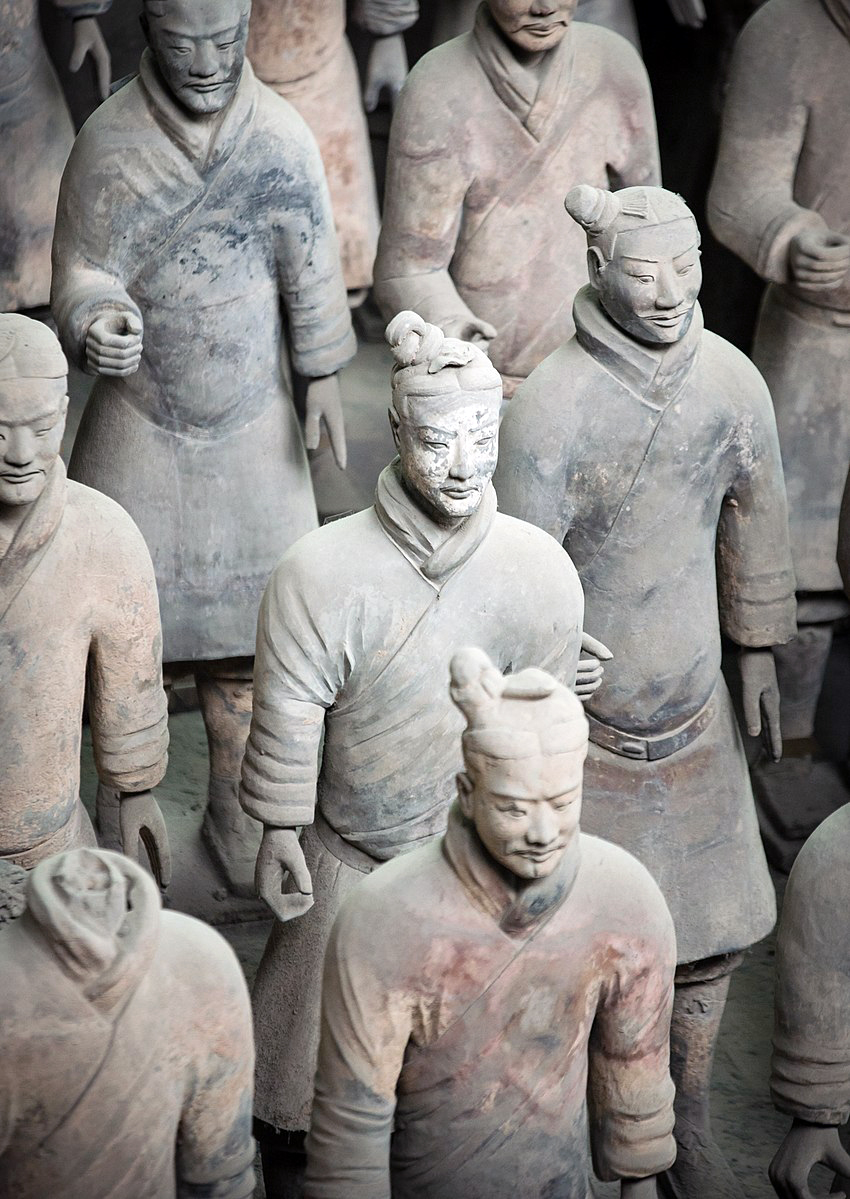
A group of infantrymen in Pit 1, Army of the First Emperor of Qin, Lintong, China, Qin dynasty, c. 210 B.C.E., painted terracotta (photo: Carlos Adampol Galindo, CC BY-SA 2.0)
Looking at them from a distance in their original excavation site at Lishan (near the city of Xi’an in Shaanxi Province, China), the warriors look like a mass of identical figures or a giant’s set of toy soldiers. But up close, your impression of them changes—every figure seems to depict a unique individual, with different shapes of tunics, features, and hairstyles. Each soldier has a carefully rendered, bulky tunic, fastened with delicately tied knots, and strong gaze, making it seem as if you are confronting a person from thousands of years ago.
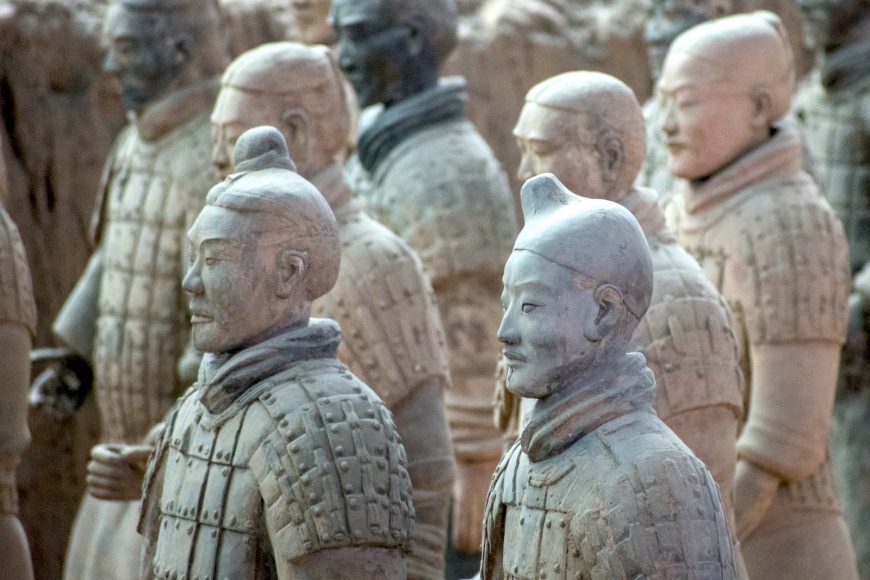
Army of the First Emperor of Qin in pits next to his burial mound, Lintong, China, Qin dynasty, c. 210 B.C.E., painted terracotta (photo: scottgunn, CC BY-NC 2.0)
Some of the earliest scholars to write about the Terracotta Warriors describe them as portraits of the army of the First Emperor of China—replicas of actual soldiers who once lived—that the great 3rd-century state-builder, Qin Shi Huangdi, took to his grave.
But who are we really looking at? Are these truly portraits of soldiers from 3rd-century B.C.E. China?
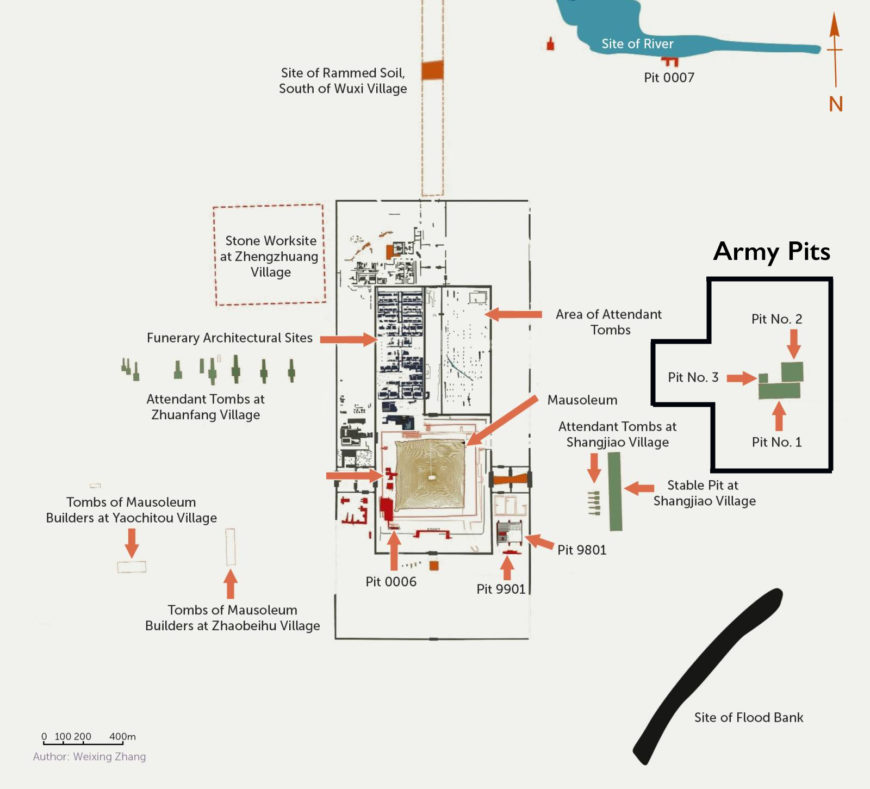
Plan of the tomb complex, Mausoleum of Emperor Qin Shi Huangdi (diagram Weixing Zhang; modified by Alexandra Nach). The pyramid-shaped tumulus and the Army Pits, currently the site of the Museum of the Tomb of the First Emperor, are 1.22 km/0.75 miles away from each other.
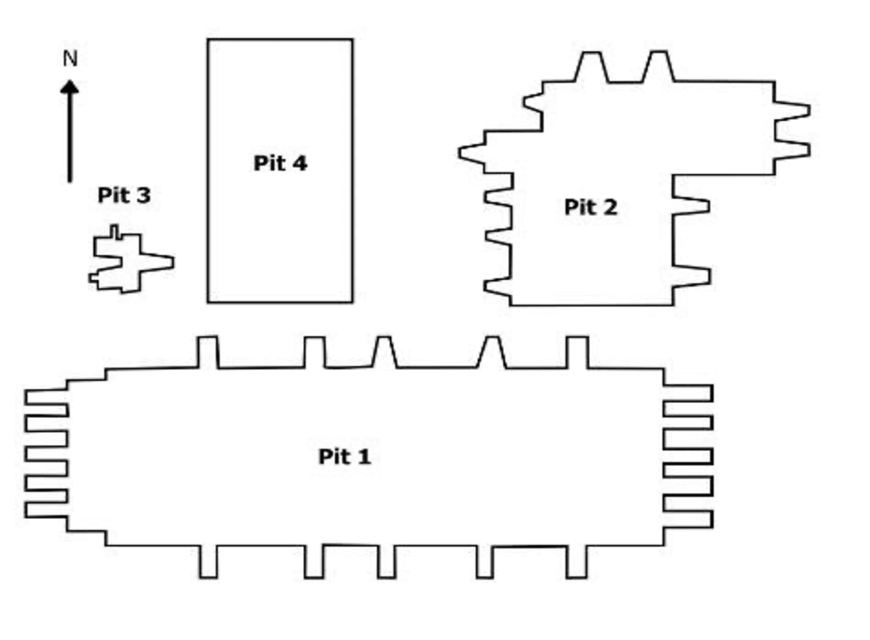
Diagram of the four pits (the Army Pits) first excavated in the Tomb complex of the First Emperor
The Army pits
The Terracorra Warriors were discovered accidentally in 1974 by farmers who, while digging for a well, unearthed several figures. Archaeological investigation soon revealed four large underground chambers (referred to by the archaeologists as “pits,” and these particular areas are referred to as the “army pits”), three of which contained shattered fragments of warriors made in terracotta. While the location of the tomb mound of the First Emperor had long been known, the terracotta figures were a dramatic departure from anything mentioned in the written record, or found in other tombs.
Pit no. 1
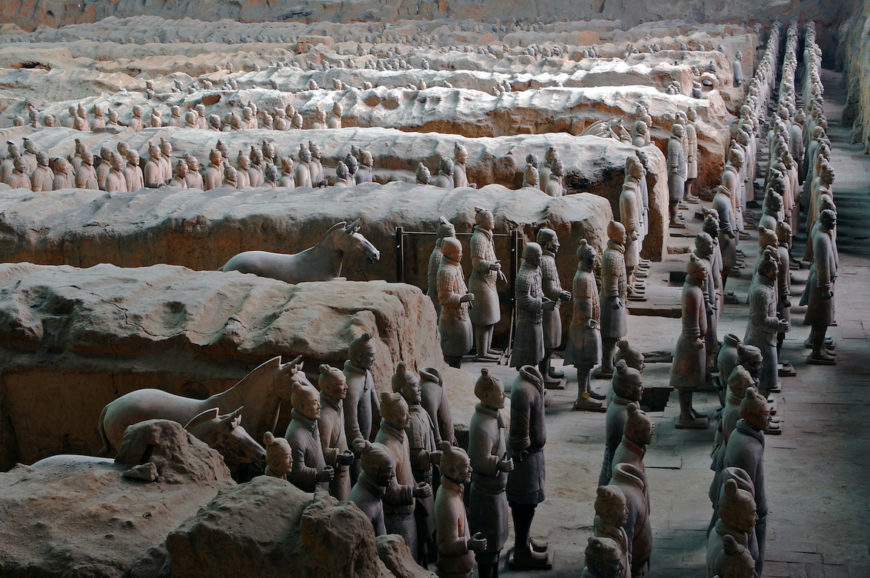
View of Pit 1, Army of the First Emperor of Qin, Lintong, China, Qin dynasty, c. 210 B.C.E., painted terracotta (photo: Tym, CC BY-NC-ND 2.0)
Pit no. 1 is the largest of the Army Pits. It is a large compartment dug into the earth, whose walls were reinforced with logs and covered by a wooden ceiling. Inside, it is split by earth embankments into 11 corridors containing soldiers lined up in battle formation. The massive pit was covered with a roof of heavy wooden beams, with five broad ramps on each side allowing workers to transport the terracotta soldiers into the lamp-lit tomb as they were being made. The panoramic view of the pit that we are presented with today, the result of removing the massive wooden beams composing the roof, is not one the workers (or even the Emperor) would have seen, but rather a curated experience enjoyed by the modern museum-going public.
While construction on the complex itself may have started as early as the future First Emperor’s ascent to the throne of the state of Qin in 247 B.C.E., the commonly accepted date for the start of construction of the Army Pits and the production of the terracotta warriors is around 221 B.C.E., when the unification of the Qin Empire was completed and the King of Qin declared himself the August First Emperor of China Sima Qian’s Records of the Grand Historian records that at the time over 700,000 convicts and forced laborers were relocated to the tomb construction site. While some doubt this many laborers were used, archaeological evidence and our understanding of how the soldiers were made (see discussion below) support this timeline. It was this massive workforce that managed to dig out Pit 1, removing what is estimated to be around 70,000 cubic meters of earth, the equivalent of the carrying capacity of 5,500 modern lorries!

Pit 1, 230m/754 feet long, 62m/203 feet wide and dug 5m/16.4 feet deep into the ground, Army of the First Emperor of Qin, Lintong, China, Qin dynasty, c. 210 B.C.E., painted terracotta (photo: Dennis Jarvis, CC BY-SA 2.0)
The roughly 1,900 terracotta infantrymen inside the pit are accompanied by 22 wooden chariots driven by four terracotta horses and manned by even more terracotta warriors. All the figures bear individually modeled armor, hairstyles, and headdresses that make every figure stand out as unique, and allow distinction between the ranks of the soldiers and their different roles in an army, from archers to infantrymen to charioteers. Though their armor is carefully modeled in clay, the weapons they brandished were real—the wooden components of each weapon have decayed, but the bronze spearheads, swords, and crossbow components were found by the archaeologists by the side of the soldiers. With the largest number of warriors (an estimated 6,000), Pit 1 is assumed to represent the main part of the army, reflecting the importance of infantry at a time when military dominance of a state depended on being able to assemble the largest numbers of warriors.
Pit no. 2
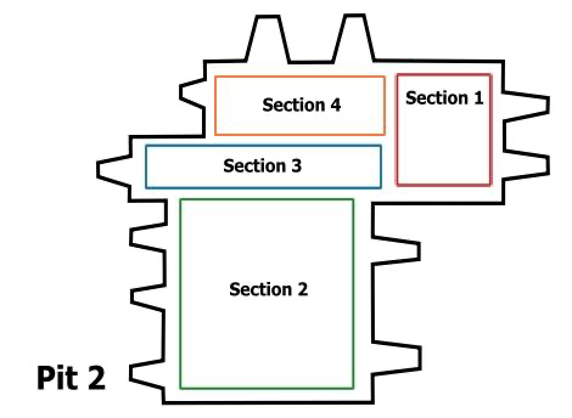
Diagram of Pit 2 in the Tomb complex of the First Emperor
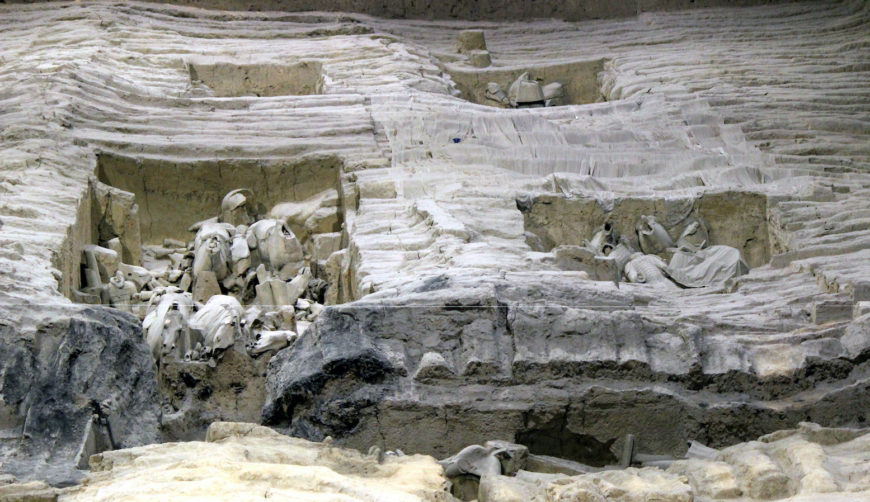
Overhead view of Pit 2, Army of the First Emperor of Qin, Lintong, China, Qin dynasty, c. 210 B.C.E., painted terracotta (photo: Aaron Zhu, CC BY-SA 3.0)
Pit 2 is split into four sections, and contains a wider mix of units. In section 1 on the eastern end, a double row of archers and spearmen stand in front of six columns of standing and kneeling archers split by embankments.
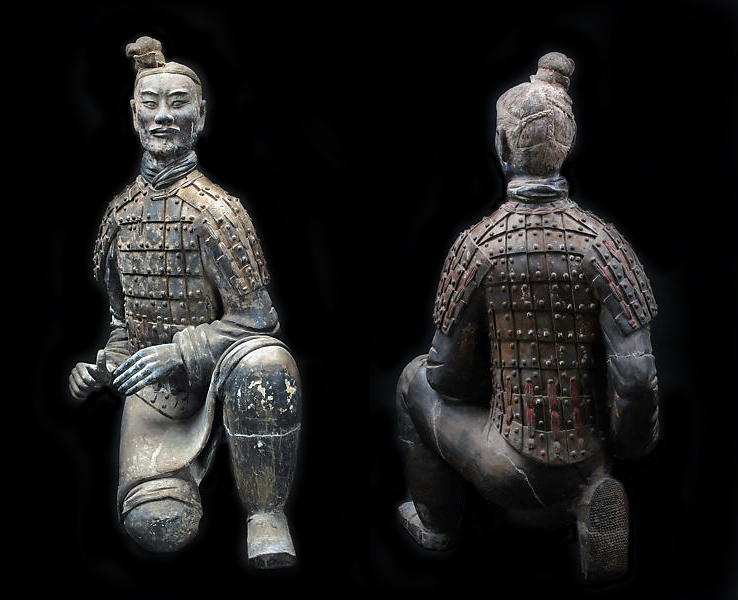
Front and back view of Kneeling Archer, Pit 2, Army of the First Emperor of Qin, Lintong, China, Qin dynasty, c. 210 B.C.E., painted terracotta
Section 2 on the southern end of the pit, on the other hand, contains primarily chariots (64 in total), each drawn by four horses and accompanied by a driver and two assistants.
Section 3 combines 19 chariots with 264 infantrymen as well as a small cavalry force at the rear.

Cavalryman and horse from Pit 2 (section 4), Army of the First Emperor of Qin, Lintong, China, Qin dynasty, c. 210 B.C.E., painted terracotta (photo: Maia C, CC BY-NC-ND 2.0)
Finally, section 4 is primarily composed of cavalry, with 108 cavalrymen and their saddled horses headed by a group of 6 chariots. At the time of the First Emperor, the use of cavalry was a relatively recent innovation, only introduced to China in the 4th century B.C.E. Qin was one of the first states to establish a cavalry as part of their military force, a move that was instrumental to the unification efforts of the First Emperor. The cavalryman here is depicted with his saddled horse, dressed in a short armor jacket worn over a robe with pleated skirt designed to permit ease of riding.
Pit nos. 3 and 4
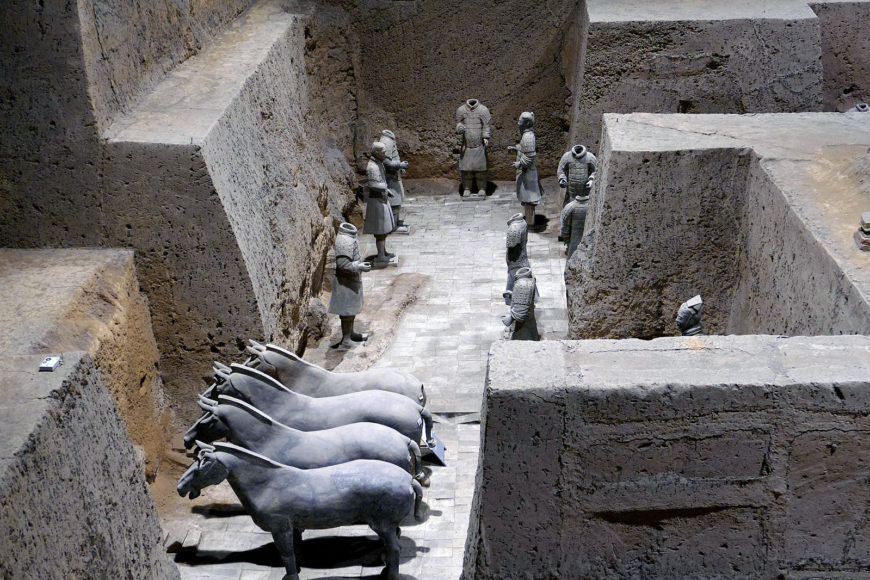
View from above of Pit 3, Army of the First Emperor of Qin, Lintong, China, Qin dynasty, c. 210 B.C.E., painted terracotta (photo: Zossolino, CC BY-SA 4.0)
Pit 3 is the smallest and most sparse of the three, and also the most puzzling. U-shaped, it houses 22 armored infantrymen in its north wing, and 42 in the south wing. While the military formations in the others face east, as if in preparation to be deployed away from the mound, the soldiers here face each other, as if expecting a commander to enter from the central chamber. Uniting the two wings is a central space housing a chariot that faces the main ramp to the east side (not pictured nor displayed due to its fragility). Unlike the chariots in the other pits, it was painted over with lacquer in vibrant geometric motifs and covered by a round canopy, all of which are signals that this was the vehicle of a member of the high command. Some scholars argue that the lavish chariot could have served as a symbol of the implied presence of the First Emperor as supreme military commander.
A fourth pit was excavated but contained no soldiers—perhaps not having been finished on time. What was the purpose of the vast assembled army in these pits?
An empire inside a tomb
Burying attendants in tombs close to the ruler, as well as burying important symbols of rulership like chariots or ritual bronze vessels in royal tombs, had long been common practice in China before the time of the First Emperor. Often musical instruments and items of furniture were buried in compartments around the burial chamber, turning these compartments into “rooms” dedicated to individual activities. Modeling tombs as replicas of the houses of the living is an important feature of Chinese mortuary culture one that developed over long period time. Starting from around the 6th century B.C.E, replicas of household utensils and, occasionally, small figurines representing attendants to serve the tomb occupant in the afterlife, were increasingly found in tombs.
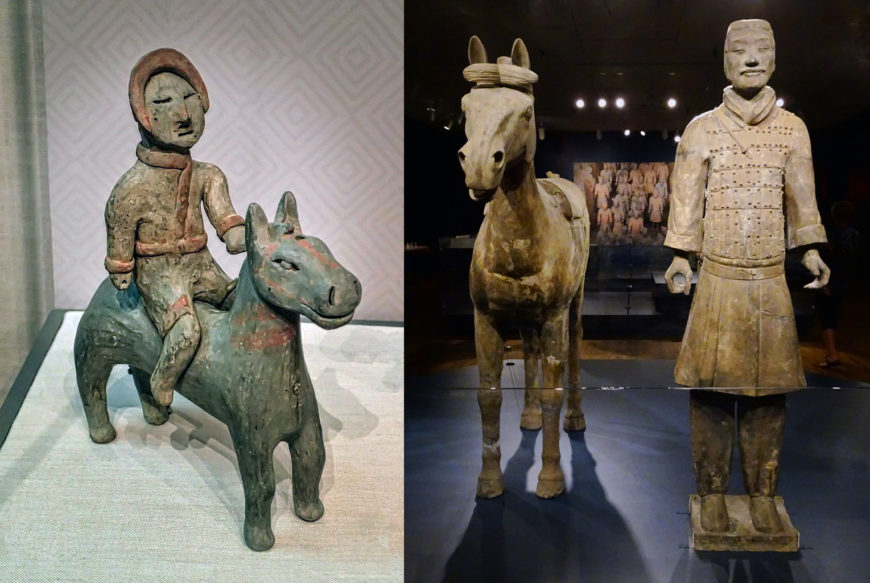
Left: Horseman, 5th–3rd century B.C.E., painted earthenware, unearthed at Tomb 2, Steel Factory, Xianyang, Shaanxi Province, 23.5 cm high, 17.5 cm in length (photo: mharrsch, CC BY-NC-SA 2.0); right: Cavalryman and horse from Pit 2, Army of the First Emperor of Qin, Lintong, China, Qin dynasty, c. 210 B.C.E., painted terracotta (photo: Maia C, CC BY-NC-ND 2.0)
The tomb complex of the First Emperor is a major turning point in this development. The life-sized, intricately worked figures in the complex are a dramatic and abrupt departure from the small figurines of earlier tombs. Furthermore, rather than representing an article to be placed in a tomb, the First Emperor’s terracotta figures define the space around them, like actors on a stage, who through their costumes and actions allow us to imagine garrisons, stables, offices, and gardens.
Although we may not know the full context, the figures’ convey the bustle of activity and a variety of roles working under the emperor. They capture not only specific spaces around the imperial palace, like the Shanglin garden or a garrison, but also the staff and tools involved in running an Empire: from generals, to officials, to chariot drivers with their mighty chariots, to soldiers holding real weapons, to humble stable boys.
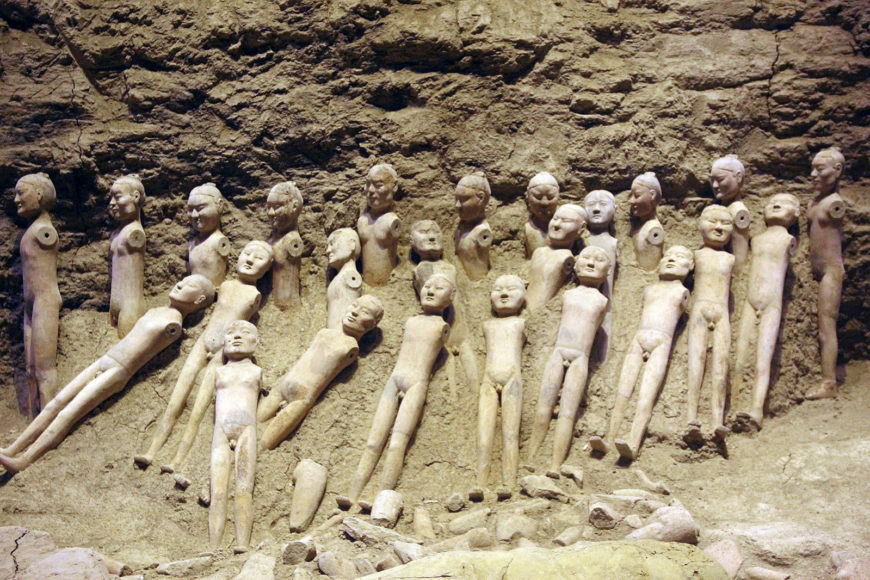
Earthenware figurines, before 141 B.C.E., excavated at the Mauseoleum of Prince Jing at Yangling, Shaanxi Province, between 30 and 60 cm (Han Yangling Museum; photo: Gary Todd, CC0 1.0)
While later tombs of the Han dynasty, including those of emperors, also contained ceramic figurines of different occupations engaged in little “scenes” mirroring everyday life, none of them were of the same size and artistic accomplishment as those in the tomb of the First Emperor. For example, the mausoleum of Emperor Jing, one of the largest Han imperial tombs, yielded over 50,000 figurines. However, they were only a third of the size of the First Emperor’s terracotta figures, and were rendered with significantly less detail in their clothing or individuating variety in their faces. The focus of these later tomb figurines also shifted away from officials and soldiers serving the Empire to household servants, attendants, and entertainers, as well as model granaries and herds of livestock.
The reason for the sudden emergence of these life-sized, detailed figures has puzzled scholars for generations. As some have pointed out, prior to the terracotta warriors China lacked a tradition of large-scale sculpture in the round. When the human body was depicted in early Chinese art, it was mostly as small figurines with little attention to muscle definition in figures. Could the First Emperor, in his ambition to create a tomb like no other, have looked outside China, to Central Asia, where life-like Hellenistic Greek sculpture was used in tombs and temples?
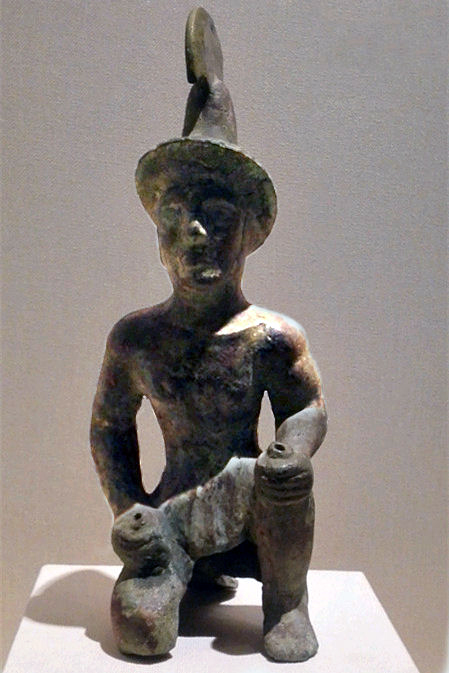
Figure of a kneeling warrior, bronze, Xinjiang, 40 cm high (Xinjiang Institute of Archaeology)
Proponents of this theory point to mentions in the written records of the First Emperor casting twelve gigantic bronze sculptures (sadly all destroyed by the 4th century C.E.) in response to the appearance of “giants . . . in foreign robes” in the western provinces of the empire, interpreted by proponents of this theory as references to Hellenistic Greek sculpture. Archaeological finds in the western Gansu province and the Tarim Basin further west confirm that this area functioned as a corridor for trade between China and wider Eurasia. A kneeling bronze figure, depicted with a bare chest and what looks like a Greek Phrygian helmet, was excavated in the Ily River Valley in Xinjiang, confirming that bronze sculpture traveled along this early Silk Road.
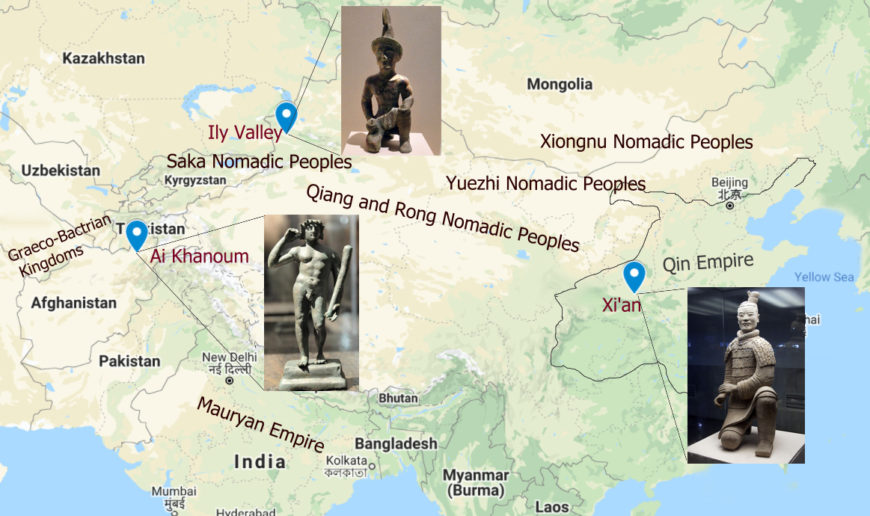
Map of early trade routes during the Qin dynasty
The nomadic peoples inhabiting the Tarim Basin and the Gansu corridor were major players in the movement of objects and technologies between Central Asia and China at this time. While the First Emperor often antagonized nomadic groups as part of his campaigns of expansion, the Records of the Grand Historian mention that he singled out certain nomadic groups as important trade partners. The presence of molds for making belt plaques in nomadic style, used to make elegant pieces such as one in the tomb of a 3rd century B.C.E. Qin smith from a suburb near Xi’an (now in The Metropolitan Museum of Art), is evidence of not only the lively trade between the Qin and the nomads, but also the willingness of Qin craftsmen to adopt foreign technologies.
Whether or not the makers of the First Emperor’s mausoleum were inspired by developments outside China remains a point of debate in the research on the tomb of the First Emperor, and it does not answer why the First Emperor and his tomb planners sought to include life-sized realistic sculptures so unlike anything that came either before or after. Some have seen this choice as a feat of grandomania, or the First Emperor’s wish to have nothing short of life-sized figures representing the grandeur of his empire. Other scholars have argued that this was part of the attempt to re-create the world of the living in the tomb: the more life-like the soldiers and other staff were, the more efficient they would be in serving the Emperor in the afterlife. In other words, the ability to render life-sized human and animal figures may have been seen as magical in itself, and their skillfully rendering and accurate detail acted as an enchantment.
This raises, however, a further question. If the tomb of the First Emperor mirrors his Empire, were his Terracotta Warriors also “portraits” of his living soldiers? Looking at how the terracotta figures were made sheds some light on this question.
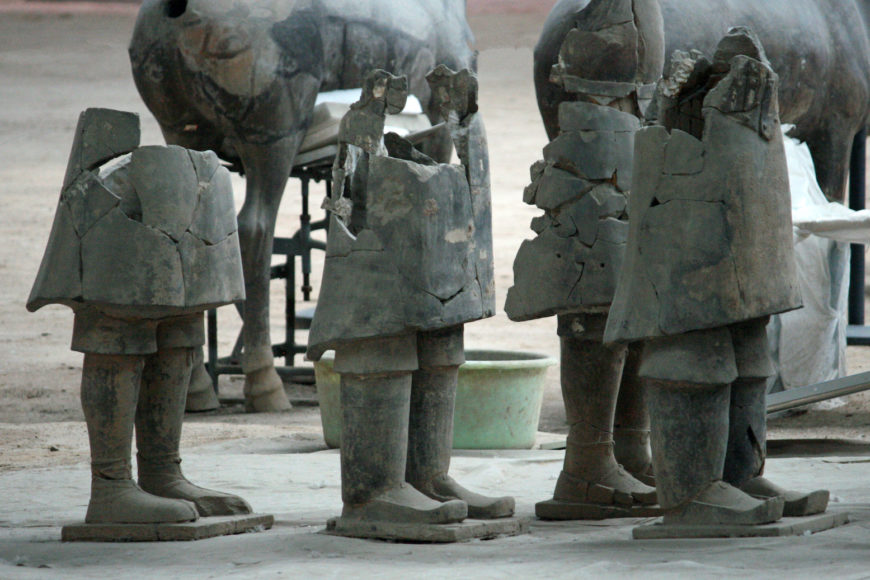
Detail of lower part of incompletely reconstructed Terracotta Warriors, Army of the First Emperor of Qin, Lintong, China, Qin dynasty, c. 210 B.C.E., painted terracotta (photo: Tom Thai, CC BY 2.0)
Making the cast of the afterlife
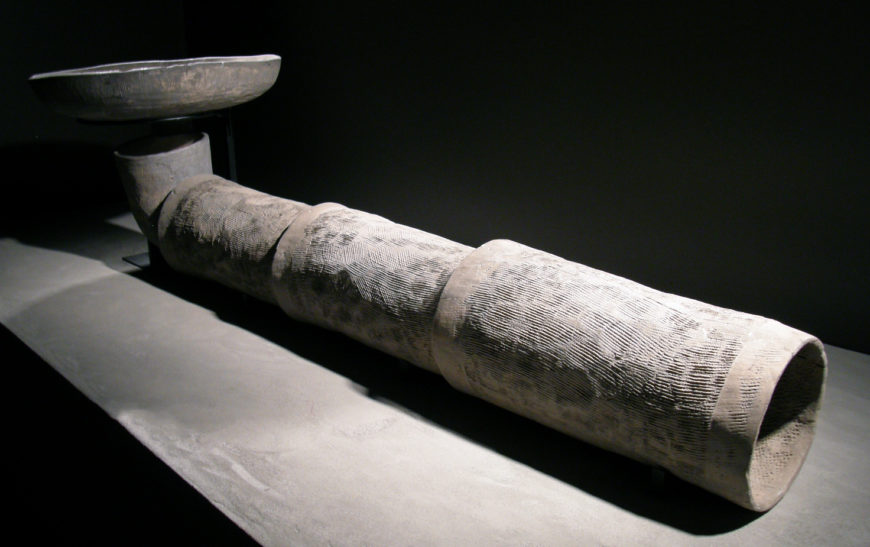
Earthenware pipes, Qin Dynasty, Army of the First Emperor of Qin, Lintong, China, Qin dynasty, c. 210 B.C.E., painted terracotta (photo: IslesPunkFan, CC BY-NC 2.0)
Warriors’ faces are modeled in detail and with great care—but not their legs and feet which are plainly modeled. They have wide, bulky shoes and stocky legs shaped like rough cylinders that connect to the upper thighs covered by the coat.
There is a structural reason for the legs being rough and thick—they support the weight of the body, which the artists build from the bottom up. They also tell us something important about the way the soldiers were made—they are simple clay cylinders made in the same way that ceramic drainpipes were made in the tomb. Segments of Qin drainpipes were made by pressing rolls of clay into a cylindrical shape. In fact, many of the parts of the soldiers are constructed of simple parts made from pressing clay into molds and joined together like the drainpipes.
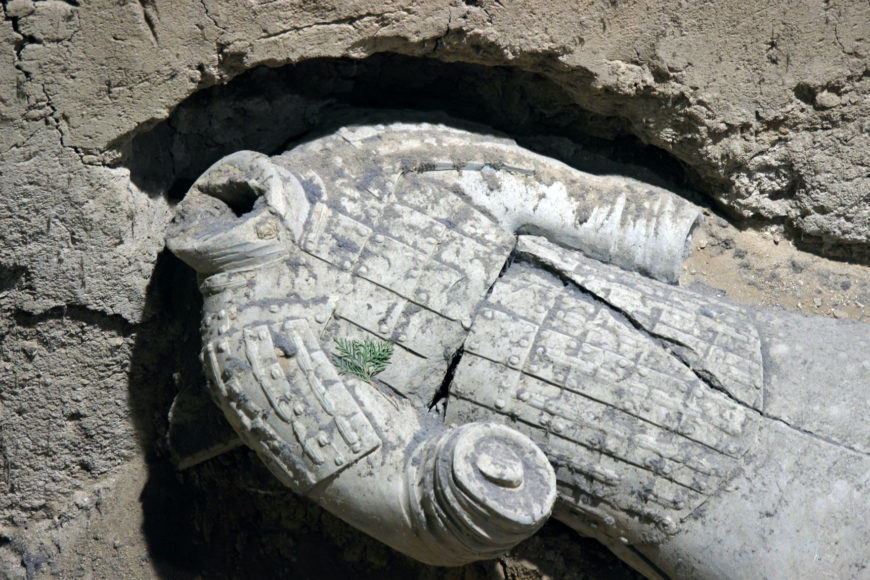
Detail view of the upper body of a warrior whose head has gotten detached, Tomb of the First Emperor of Qin, Lintong, China, Qin dynasty, c. 210 B.C.E., painted terracotta (photo: askaped, CC BY 2.0)
Warriors’ torsos and lower bodies, covered by armor and tunics, were made in one or two pieces by coiling as well as slab building. Using molds and applying additional bits of clay, the surface of each torso was worked into the armor and clothing detail.
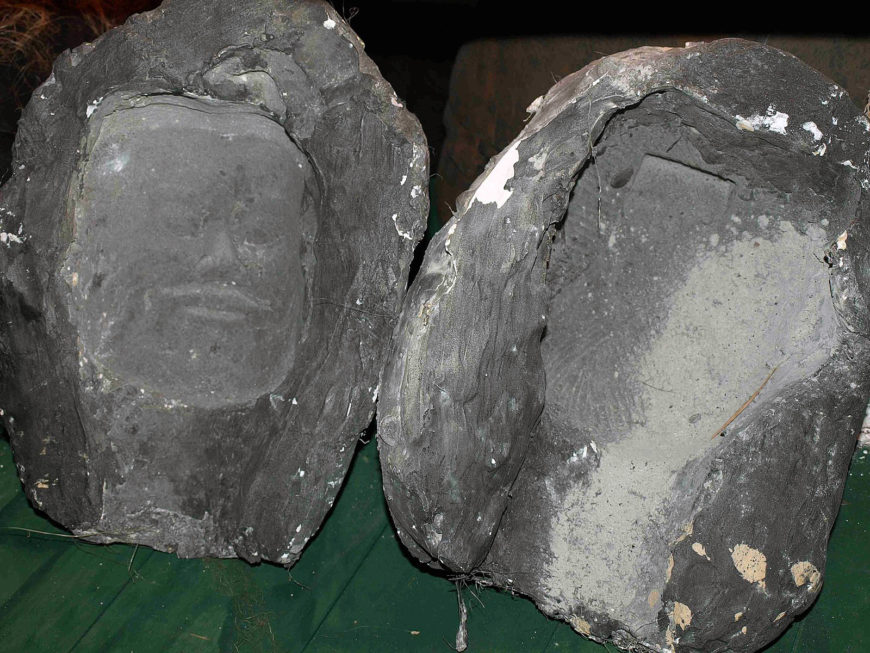
Two halves of the mold used for the head of a terracotta warrior, Tomb of the First Emperor of Qin, Lintong, China, Qin dynasty, c. 210 B.C.E., painted terracotta (photo: Prosopee, CC BY-SA 3.0)
The arms, heads, and hands were produced separately, by pressing clay into molds, and later attached to the torso using clay slip. There was only a limited number of molds being used for every part of the body: two types have been identified for the feet, three for shoes, eight types of torsos, two types of hands, and eight types for faces.
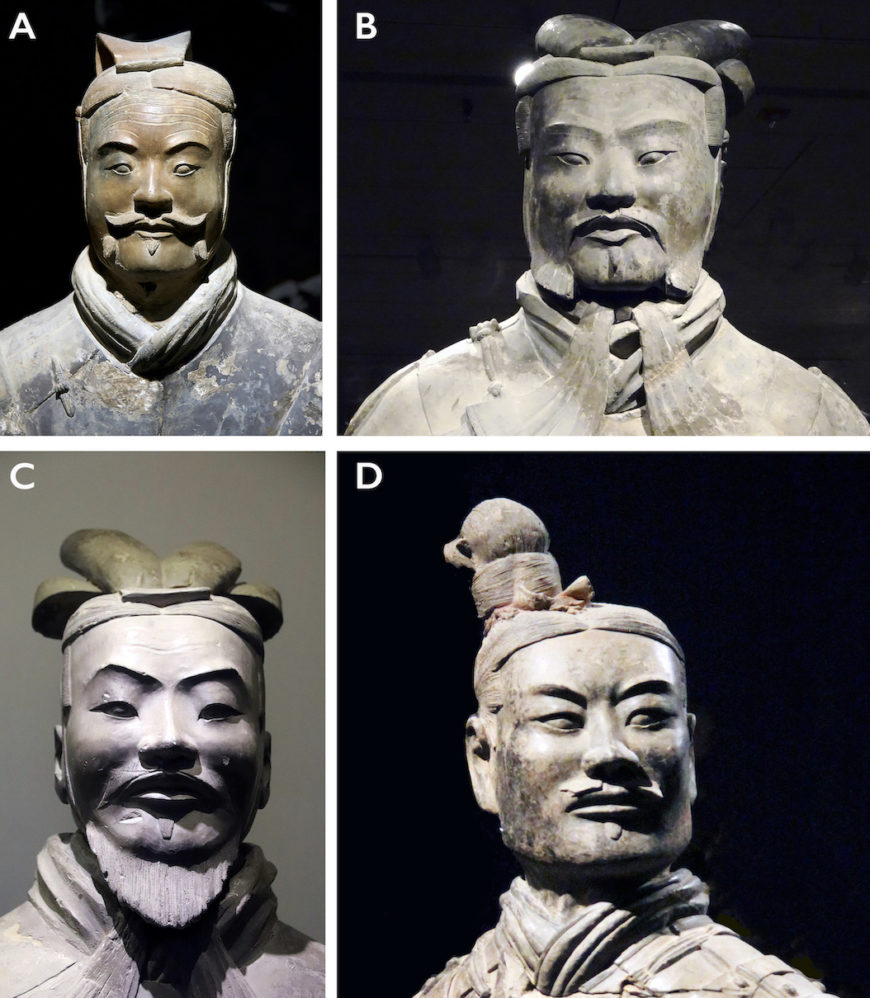
Four faces of different terracotta warriors, Tomb of the First Emperor of Qin, Lintong, China, Qin dynasty, c. 210 B.C.E., painted terracotta (photo A: David Castor, CC0 1.0); B: Maia C, CC BY-NC 2.0; C: Gary Todd, CC0 1.0; and D: James H., CC BY-NC 2.0)
But then, why does each soldier look different? Each individual face had different types of mustaches and eyebrows attached, while the artisans subtly modified the details to create a sense of individuality, age, and sometimes even emotion. Fine lines were carved into the foreheads to show age (such as figures A and B above), while eyebrows were reshaped into frowns of concentration (such as figures C and D above). While some modifications conveyed personality, others established what category each soldier belonged to, like the “pheasant-tail headdresses” which identify B and C as generals.
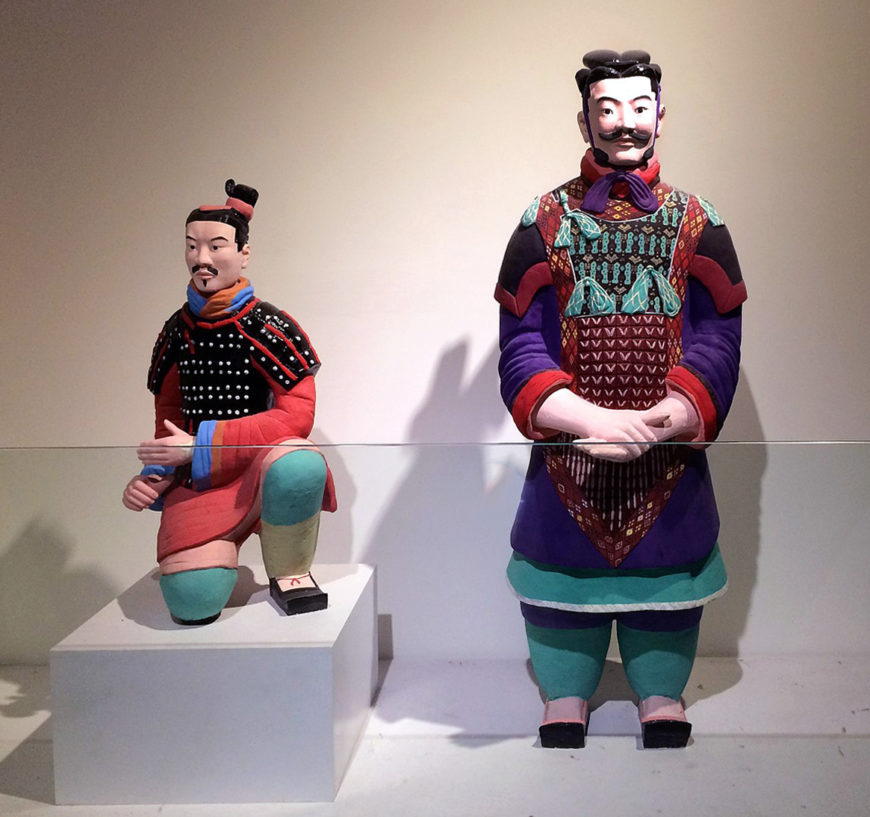
Reconstruction of the original pigmentation on the soldiers (photo: Charlie, CC BY-SA 4.0)
After the figures were modeled, they were fired in a kiln and then painted with lacquer colored with strong pigments, like bright malachite, cinnabar, and azurite, alongside “Han purple.”

View of the soldiers at their discovery with visible traces of paint, Tomb of the First Emperor of Qin, Lintong, China, Qin dynasty, c. 210 B.C.E., painted terracotta (The Museum of Qin Terra-cotta Warriors and Horses, Xi’an; photo: edward stojakovic, CC BY 2.0)
Pictures of the soldiers at the time of excavation show how brightly colored they would have originally been; most of the paint dissolved shortly after excavation, though traces remain on the soldiers.
Making the warriors was not the work of a single artist working from a model, but the joint effort of a workshop team working with set molds. We know a lot about how such teams were set up. Each soldier is marked with an inscription that states the leading foreman of a team, their place of origin, and the name of their workshop.
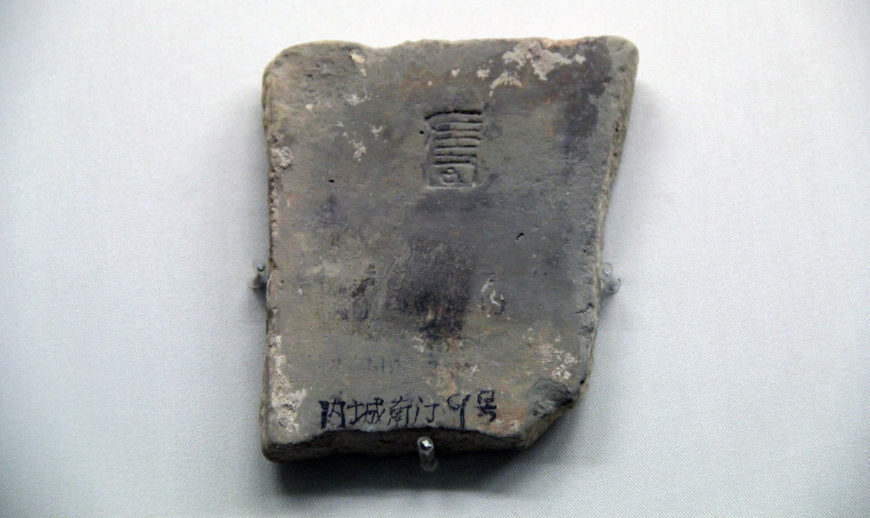
A workshop stamp on a Qin-period tile (Museum at Qin Shihuang Mausoleum, Lintong; photo: Gary Todd, CC0 1.0)
Since some of the workshop names match the names stamped on tiles excavated in the First Emperor’s capital, we know that they were recruited from existing pottery workshops. The stamps allowed for a strict system of quality assurance, in which the foremen responsible for any fault in a product would be fined. It was this culture of strictly enforced standardization, already established in his home state of Qin, that allowed the First Emperor to re-shape the states he conquered into a centralized empire.
This modular, efficient production does not detract from the artistic achievement of the Terracotta Warriors. We may never know whether the workers modeled the features on actual soldiers who guarded the compound, on their fellow workers, or merely used their imagination, but they successfully imbued each figure with individuality. Like characters in a play, the soldiers and other terracotta figures were created specifically to enact a part of the world of the First Emperor in the afterlife. Even though we may not be looking at individual portraits of the soldiers of the First Emperor, the Terracotta Warriors successfully lead us to think that we are, and set them apart from ceramic tomb figures both before and after those of the First Emperor.

